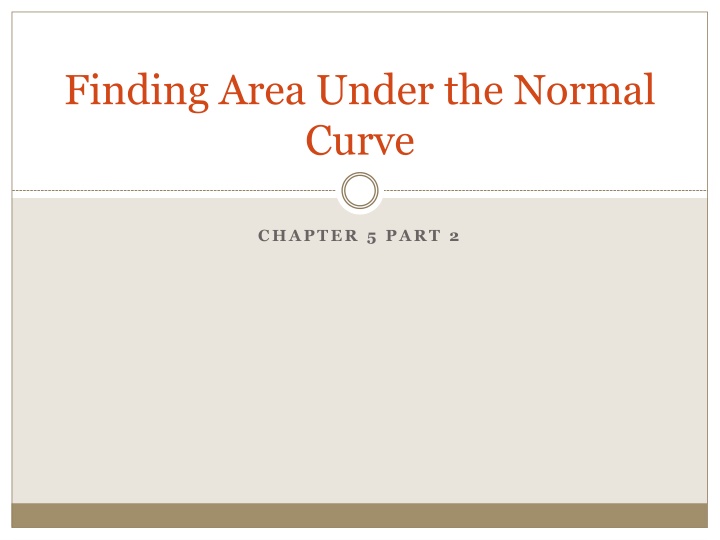
Normal Distribution and Area Calculation
Delve into the world of normal curves and Z-scores to predict probabilities accurately. Learn how to use the 68-95-99.7% Rule and calculator functions to find areas under the curve for different scenarios.
Download Presentation

Please find below an Image/Link to download the presentation.
The content on the website is provided AS IS for your information and personal use only. It may not be sold, licensed, or shared on other websites without obtaining consent from the author. If you encounter any issues during the download, it is possible that the publisher has removed the file from their server.
You are allowed to download the files provided on this website for personal or commercial use, subject to the condition that they are used lawfully. All files are the property of their respective owners.
The content on the website is provided AS IS for your information and personal use only. It may not be sold, licensed, or shared on other websites without obtaining consent from the author.
E N D
Presentation Transcript
Finding Area Under the Normal Curve CHAPTER 5 PART 2
Recall the Normal Curve Model Z-scores Each tick mark (z- score) is a distance of one Standard Deviation Values that are 2 < ? < 2 are considered typical Values that are ? < 3 and ? > 3 are considered unusual The farther from the center, the more unusual the value becomes z-scores
It turns out that there is a specific amount of area under the curve bounded between these z-scores and we can use this area to predict the probability of its occurrence! For data that are unimodal and symmetric, about 68% fall within 1 SD of the mean, 95% fall within 2 SDs of the mean, and 99.7% fall within 3 SDs of the mean. This is the 68-95-99.7% Rule.
The 68-95-99.7% Rule is an approximation. We can get better accuracy using our calculator. Your calculator uses normalcdf( lower z , upper z) format. Follow the keystrokes on the left to calculate the area under the curve between -1<z<1. Normalcdf(-1,1) = 0.6826894809 About 68% Find Area 2nd VARS #2 normalcdf( Depending on your calculator -1,1) ENTER OR Lower: -1 Upper: 1 ? = 0 ? = 1 Paste ENTER
Did you get a syntax error? Make sure you are using the little negative sign on the bottom right of the calculator and not the subtraction sign in order to enter -1. Subtraction sign Negative sign
Try another! Follow the keystrokes on the left to calculate the area under the curve between -3.5<z<2. Normalcdf(-3.5,2) = 0.97701726469 About 97.7% Find Area 2nd VARS #2 normalcdf( Depending on your calculator -3.5,2) ENTER OR Lower: -3.5 Upper: 2 ? = 0 ? = 1 Paste ENTER
Try another! Calculate the area under the curve z>1. When it is not bounded on the right, we use 100. Normalcdf(1,100) = 0.1586552596 About 15.9% Find Area 2nd VARS #2 normalcdf( Depending on your calculator 1,100) ENTER OR Lower: 1 Upper: 100 ? = 0 ? = 1 Paste ENTER
Try another! Calculate the area under the curve z<2. When it is not bounded on the left, we use -100. Normalcdf(-100,2) = 0.977249938 About 97.7% Find Area 2nd VARS #2 normalcdf( Depending on your calculator 100,2) ENTER OR Lower: -100 Upper: 2 ? = 0 ? = 1 Paste ENTER
What if we know the area, but don t know the z-score? Your calculator uses invnorm( area on the left) format. Find z-score for bottom 5%. invnorm(0.05) = -1.644853626 = z Know Area 2nd VARS #3 invnorm( Depending on your calculator 0.05) ENTER OR Area: 0.05 ? = 0 5% ? = 1 Paste ENTER
Try another! Find z-score for upper 10%. This means that if the upper area is 10% then the lower (left) area is 90%. invnorm(0.90) = 1.281551567 = z Know Area 2nd VARS #3 invnorm( Depending on your calculator 0.90) ENTER OR Area: 0.90 90% 10% ? = 0 ? = 1 Paste ENTER
Summary Know Area Find Area invnorm( area on the left) normalcdf( lower z , upper z) Recall ? =???? ?????? ??
















